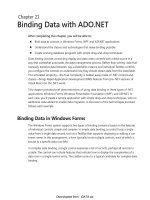Introducing ADO.NET
Bạn đang xem bản rút gọn của tài liệu. Xem và tải ngay bản đầy đủ của tài liệu tại đây (508.78 KB, 14 trang )
3
Chapter 1
Introducing ADO.NET 4
After completing this chapter, you will be able to:
Identify what ADO.NET is
Explain ADO.NET’s role in an application
Identify the major components that make up ADO.NET
Create an ADO.NET link between a database and a .NET application
This chapter introduces you to ADO.NET and its purpose in the world of Microsoft .NET
application development. ADO.NET has been included with the .NET Framework since
its initial release in 2002, playing a central role in the development of both desktop and
Internet-targeted applications for programmers using C#, Visual Basic, and other Framework
languages.
What Is ADO.NET?
ADO.NET is a family of technologies that allows .NET developers to interact with data in stan-
dard, structured, and primarily disconnected ways. If that sounds confusing, don’t worry. This
book exists to remove the confusion and anxiety that many developers experience when they
first learn of ADO.NET’s multiple object layers, its dozens of general and platform-specific
classes, and its myriad options for interacting with actual data.
Applications written using the .NET Framework depend on .NET class libraries, which exist in
special DLL files that encapsulate common programming functionality in an easy-to-access
format. Most of the libraries supplied with the .NET Framework appear within the System
namespace. System.IO, for instance, includes classes that let you interact with standard disk
files and related data streams. The System.Security library provides access to, among other
things, data encryption features. ADO.NET, expressed through the System.Data namespace,
implements a small set of libraries that makes consuming and manipulating large amounts of
data simple and straightforward.
ADO.NET manages both internal data—data created in memory and used solely within an
application—and external data—data housed in a storage area apart from the application,
such as in a relational database or text file. Regardless of the source, ADO.NET generalizes
the relevant data and presents it to your code in spreadsheet–style rows and columns.
Dwonloaded from: iDATA.ws
4
Microsoft ADO.NET 4 Step by Step
Note
Although ADO.NET manipulates data in tabular form, you can also use ADO.NET to access
nontabular data. For instance, an ADO.NET provider (discussed later in the chapter, on page 7)
could supply access to hierarchical data such as that found in the Windows Registry, as long as
that provider expressed the data in a tabular structure for ADO.NET’s use. Accessing such non-
tabular data is beyond the scope of this book.
If you are already familiar with relational databases such as Microsoft SQL Server, you will
encounter many familiar terms in ADO.NET. Tables, rows, columns, relations, views; these
ADO.NET concepts are based loosely on their relational database counterparts. Despite these
similarities, ADO.NET is not a relational database because it doesn’t include key “relational
algebra” features typically found in robust database systems. It also lacks many of the com-
mon support features of such databases, including indexes, stored procedures, and triggers.
Still, if you limit yourself to basic create, read, update, and delete (CRUD) operations, ADO.NET
can act like a miniature yet powerful in-memory database.
As an acronym, “ADO.NET” stands for—nothing. Just like the words “scuba,” “laser,” and “NT”
in Windows NT, the capital letters in ADO.NET used to mean something, but now it is just
a standalone term. Before Microsoft released the .NET Framework, one of the primary data
access tools Windows developers used in their programs was known as ADO, which did stand
for something: ActiveX Data Objects. After .NET arrived on the scene, ADO.NET became the
natural successor to ADO. Although conceptual parallels exist between ADO.NET and ADO,
the technologies are distinct and incompatible.
Note
ADO is based on Microsoft’s older COM technology. The .NET Framework provides sup-
port for COM components, and therefore enables .NET programs to use ADO. This is especially
useful for development teams transitioning legacy applications to .NET. Although ADO and
ADO.NET components can appear in the same application, they can interact only indirectly
because their object libraries are unrelated.
When communicating with external data stores, ADO.NET presents a disconnected data
experience. In earlier data platforms, including ADO, software developers would typically
establish a persistent connection with a database and use various forms of record locking to
manage safe and accurate data updates. But then along came the Internet and its browser-
centric view of information. Maintaining a long-standing data connection through bursts of
HTTP text content was no longer a realistic expectation. ADO.NET’s preference toward on-again,
off-again database connections reflects this reality. Although this paradigm change brought
with it difficulties for traditional client-server application developers, it also helped usher in
the era of massive scalability and n-tier development that is now common to both desktop
and Web-based systems.
Dwonloaded from: iDATA.ws
Chapter 1 Introducing ADO.NET 4
5
Why ADO.NET?
In the early days of computer programming, the need for a data library like ADO.NET didn’t
exist. Programmers had only a single method of accessing data: direct interaction with the
values in memory. Permanently stored data existed on tape reels in fire-resistant, climate-
controlled, raised-floor rooms. Data queries could take hours, especially if someone with
more clout had a higher-priority processing need.
Over time, computers increased in complexity, and (as if to fill some eternal maxim) data
processing needs also expanded to consume all available computing resources. Businesses
sought easier ways to manage entire records of numeric, text, and date-time values on their
mainframe systems. Flat-file and relational database systems sprang up to establish propri-
etary management of millions of data values. As personal computers arrived and matured,
developers soon had several database systems at their disposal.
This was great news for data consumers. Businesses and individuals now had powerful tools
to transform data bits into usable information, to endow seemingly unrelated values with
meaning and purpose. But it was bad news for developers. As technology marched on, com-
panies purchased one proprietary system after another. Programming against such systems
meant a reinvention of the proverbial wheel each time a middle manager asked for yet
another one-time report. Even the standard SQL language brought little relief because each
database vendor provided its own spin on the meaning of “standard.”
What programmers needed was a way to generalize different data systems in a standard,
consistent, and powerful way. In the world of .NET application development, Microsoft ADO.NET
meets that need. Instead of worrying about the minutiae associated with the different data-
base systems, programmers using ADO.NET focus on the data content itself.
Major Components of ADO.NET
The System.Data namespace includes many distinct ADO.NET classes that work together to
provide access to tabular data. The library includes two major groups of classes: those that
manage the actual data within the software and those that communicate with external data
systems. Figure 1-1 shows the major parts that make up an ADO.NET instance.
Dwonloaded from: iDATA.ws
6
Microsoft ADO.NET 4 Step by Step
Your Source Code
ADO.NET
Entity Framework, LINQ, Other Components
Data Provider
Connection
DataSet
Command
DataAdapter
DataReader
Database
or Storage
XML File
DataTable
DataRelation
FIGURE 1-1
Key ADO.NET elements.
At the data-shaped heart of the library is the DataTable. Similar in purpose to tables in a
database, the DataTable manages all the actual data values that you and your source code
ultimately care about. Each DataTable contains zero or more rows of data, with the individual
data values of each row identified by the table’s column definitions.
Each table defines DataColumn items, each representing the individual data values that
appear in the table’s records. DataColumn definitions include a data type declaration
based on the kind of data destined for each column. For instance, a CustomerLastName
column might be defined to use data of type System.String, whereas an OrderSalesTax
column could be crafted for use with System.Decimal content.
One DataRow entry exists for each record of data stored within a table, providing access
to the distinct columnar data values. ADO.NET includes methods that let you add
to, delete from, modify, and query each DataTable object’s rows. For tables connected
to an external data storage area, any changes made can be propagated back to the
source.
You can optionally establish links between the tables of data using DataRelation entries.
Dwonloaded from: iDATA.ws
Chapter 1 Introducing ADO.NET 4
7
Programmatic limitations can be placed on tables and their data values using Constraint
instances.
DataView instances provide a limited or modified view of the rows in a DataTable.
Tables can be grouped together into a DataSet. Some tools that interact with ADO.NET
data require that any tables be bound within a DataSet, but if you plan to do some lim-
ited work with only a single table, it’s fine to work with just the DataTable instance.
DataTable instances and their associated objects are sufficient for working with internal data.
To connect with external data from a database, ADO.NET features multiple data providers,
including a custom provider for Microsoft SQL Server. Database platforms without a specific
provider use the more generic ODBC and OLE DB providers, both included with ADO.NET.
Several third-party providers can be purchased or obtained free of charge, which target spe-
cific platforms, including Oracle.
All communication with the external data source occurs through a Connection object.
ADO.NET supports connection pooling for increased efficiency between queries.
SQL queries and data management statements get wrapped in a Command object
before being sent to the data source. Commands can include optional Parameter
instances that let you call stored procedures or create fill-in-the-blank queries.
The DataAdapter object stores standard query definitions for interacting with a data-
base, removing the tedium of constantly needing to build SQL statements for each
record you want to read or write, and helping to automate some ADO.NET-related
tasks.
The DataReader object provides fast, read-only access to the results of a query for
those times when you just need to get your data quickly.
ADO.NET also includes features that let you save an entire DataSet as an XML file and load it
back in later. And that’s just the start. You’ll learn how to use all these elements—and more—
throughout the upcoming chapters.
Extensions to ADO.NET
Generalizing access to data is a key benefit of using ADO.NET. But an even greater advantage
for .NET developers is that all values managed through ADO.NET appear as objects, first-class
members of the .NET data world. Each data field in a table is a strongly typed data member,
fully compliant with .NET’s Common Type System. Individual fields can be used just like any
other local variable. Data rows and other sets of objects are standard .NET collections and
can be processed using standard iteration methods.
Dwonloaded from: iDATA.ws









